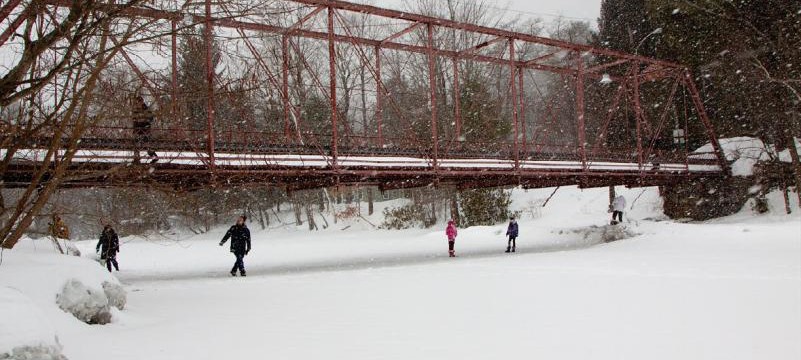City to hear latest report on effort to open historic Leeds span
Reprinted from Daily Hampshire Gazette Article
Photo by Pennington Geis
By EMMA KOLCHIN-MILLER
Gazette Contributing Writer
Thursday, May 28, 2015
(Published in print: Friday, May 29, 2015)
NORTHAMPTON — Representatives from an Iowa organization dedicated to preserving historic truss bridges will present three possibilities at a community meeting Monday for work to save the historic Hotel Bridge in Leeds: a $1.1 million full restoration of the bridge, and two repairs of $20,000 or less that would allow the bridge to reopen the bridge to pedestrian traffic while the city and the Leeds Civic Association pursue additional funding.
The civic association, which has led efforts to restore the bridge for over a decade, will hold the meeting at 6:30 p.m. in the Leeds Elementary School cafeteria, 20 Florence St. The meeting will feature a presentation from the project manager for Workin’ Bridges of Grinnell, Iowa, a consulting and contracting firm that conducted an engineering study of the bridge in March.
Julie Bowers, project manager for Workin’ Bridges, said the “Scope of Work and Estimates” she will present Monday constitutes a bid for the firm to complete the engineering and construction work, if city officials decide to move forward with the project.
In addition to the Workin’ Bridges presentation, the meeting will include a question-and-answer session and a slideshow, said civic association vice president Heidi Stevens.
Workin’ Bridges is the second firm to study the bridge. Last summer, a study by Stantec Consulting Service Inc. of Northampton — funded by a $35,000 Community Preservation Act grant — found the bridge to be unsafe and in need of extensive repairs.
The Department of Public Works fenced off the bridge after the Stantec study was released.
“It was technically closed to all traffic before the study, but once the study was done they actually chained it off,” Leeds Civic Association president Sue Carbin said of the bridge. “So this is where it becomes a hardship for us. Everybody who walks in this town — and everybody walks in this town — is missing that route of going down Mulberry, down Water, across the bridge.”
Mayor David Narkewicz echoed disappointment over the bridge’s closing, and offered city support to help the restoration effort.
“The bridge has degraded over time, and it’s been disappointing that it’s had to be closed because of safety concerns,” Narkewicz said. “To the extent that we can work with them and hopefully restore it as at least a foot bridge and bike bridge, that’s exciting and hopefully we can achieve that.”
Restoration costs
Both the Stantec and Workin’ Bridges studies estimate that a full restoration of the bridge would cost over $1 million and require repairs to the deck, rails, and underside of the bridge.
The Stantec study pegged the cost of repairs to be upward of $1.5 million. Repairs listed in the Stantec report included work on the deck — which has holes open to the river below — railings, and significant repairs to the floor beams, stringers, and truss members, which need to be strengthened.
The Stantec study also called for $650,000 to clean and repaint the bridge — a task and price tag civic association members initially questioned because the work would not address safety issues. The Workin’ Bridges study arrived at a similar estimate for cleaning and repainting the bridge — and the work will eventually be necessary, Bowers said.
She said that while her firm estimates the cost of a full restoration to be $1.1 million, it could cost less than $20,000 to safely reopen the bridge to pedestrian traffic. Those repairs would cover immediate safety hazards such as the holes in the decking, broken bolts, and a lack of adequate fencing, Bowers said.
The Workin’ Bridges estimates include two “repair to reopen” options. Under the least expensive option, estimated at $13,700, the bridge would reopen with an 8-foot-wide pedestrian and bicycle lane. A second repair plan estimated at $20,300 would include asphalt patches to the bridge decking. Both options could allow the bridge to reopen this summer, Bowers wrote in a letter to Carbin and Department of Public Works director Edward S. Huntley.
“We could come in and repair the broken bolts and put in some fencing and fix the decking so that it could be open for limited crossing while they come up with the money for the bulk of the repairs,” Bowers said.
“They have submitted a scope-of-work report with costs,” Stevens said. “They would definitely be considered for both jobs.”
Bowers said Workin’ Bridges reached out to the civic association and offered to do the second study for $6,000 after reading news reports about efforts to restore the bridge.
To pay for the Workin’ Bridges contract, the Community Preservation Committee approved the use of roughly $5,000 left over from the $35,000 CPA grant that funded the Stantec study, and the civic association contributed $1,000 of its own money, Carbin said.
“They come in pretty close to each other,” Carbin said of the two estimates.
Of the choice to hire Workin’ Bridges for a second study, Carbin said, “We wanted Workin’ Bridges because they actually are a company that is passionate about saving old iron bridges, and they really know old iron.”
Huntley said Stantec was one of two companies to submit a proposal to lead the initial study, and Workin’ Bridges did not emerge as a possibility until recently.
Next steps
Stevens, the civic association vice president, said it will be the city’s decision whether to proceed with the less expensive repairs and reopen the bridge. The civic association is willing contribute roughly $5,000 it has raised and help apply for a CPA grant for the work, she said.
“We are well aware that it will take several years to acquire the funding for a full restoration, but there are smart, creative and dedicated people who are willing to help,” Stevens said in an email.
Stevens said she hopes city officials will come to Monday’s meeting to learn about the repair options.
Narkewicz said that if scheduling does not permit him to attend Monday’s meeting, he will send a representative from his office.
Huntley agreed that money for repairs could come from fundraising and grants, with additional funding opportunities if the bridge receives a national historic designation.
“The biggest thing is the funding, of how we would find the money to replace this,” Huntley said.
Civic association members hope to succeed in a campaign to have the bridge listed on the National Register of Historic Places, which would make the restoration project eligible for federal grants. Last month, the Department of Public Works submitted the civic association’s nomination for the bridge to the Massachusetts Historical Commission. That agency will evaluate the nomination — a process that could take 14 to 18 months — before sending it on to the national historic register.
The nomination included a letter of support from Mayor Narkewicz.
“The Hotel Bridge is not only symbolic of the manufacturing history around Leeds, but is part of a larger American architectural and engineering story,” Narkewicz’s letter reads in part. “Today, Leeds remains a thriving part of Northampton — and the ability to restore the bridge would serve as a useful link between the extension of the Norwottuck Rail Trail and the Roberts Hill conservation area and Musante Beach swimming area, offering pedestrians and bicyclists a connection to local recreational resources.”
In an interview, Narkewicz pledged continued support for the effort.
“We’ve been trying to be supportive of that effort to secure placement on the historic register, and then we’ll continue to try to be supportive in assisting them with the effort to restore the bridge,” Narkewicz said. “I know that there’s private fundraising going on, and there are obviously other historic preservation kinds of funds out there that we can work with them on.”
Carbin said she has seen significant community support for the project.
“Most of the people who live in Leeds have used that bridge and miss it,” she said. “I hope we get a lot of questions from people in the community as to what they’d like to see.”
A meaningful bridge
The single-lane iron truss bridge, sometimes called Old Shepherd Road Bridge, was built in 1880 and is the oldest bridge in Northampton. Over the years, it offered a river crossing to stagecoaches and then cars, but it has been closed to vehicle traffic since 2004.
“It’s really a part of the history of Northampton that needs to be preserved,” said Ward 7 City Councilor Alisa F. Klein. “It’s just been a vital factor in the life of the village of Leeds and Northampton as a whole.”
Leeds resident Tom Quinn offered childhood memories that included jumping off the bridge into the river with his friends, and fishing beneath the bridge. He said he took his daughter, 10, fishing under the bridge last weekend — though he wishes she could enjoy full access to it.
“It’s just sad to see the state that the bridge is in now — closed, off limits. It’s just sitting there rotting,” Quinn said.
According to Jason Johnson, chairman of the Leeds chapter of the Mill River Greenway Initiative, the bridge offers a connection to both the history of Leeds and the river.
“It gives you not only a sense historically of what was going on in the town 150 years ago, but it also puts you in a really unique vantage point to see the river and experience what’s going on from its very center,” Johnson said.
Narkewicz reiterated the bridge’s value to “ecotourism” in Northampton.
“We have a lot of people come to Northampton to ride and experience our bike trails, so to the extent that this becomes another spur off of or a link as part of our existing rail trail system, I think it adds that value as well,” Narkewicz said.



